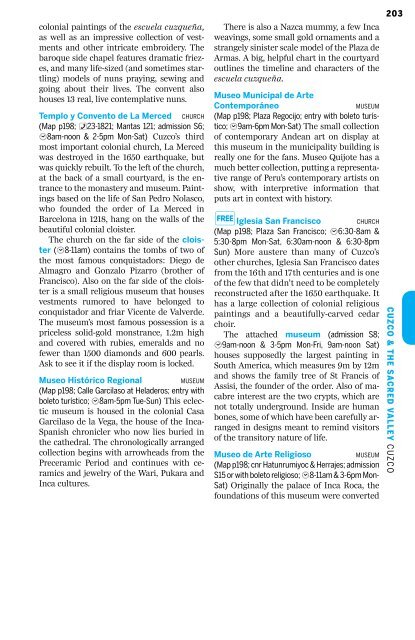peru-8-cuzco-sacred-valley
Create successful ePaper yourself
Turn your PDF publications into a flip-book with our unique Google optimized e-Paper software.
colonial paintings of the escuela cuzqueña,<br />
as well as an impressive collection of vestments<br />
and other intricate embroidery. The<br />
baroque side chapel features dramatic friezes,<br />
and many life-sized (and sometimes startling)<br />
models of nuns praying, sewing and<br />
going about their lives. The convent also<br />
houses 13 real, live contemplative nuns.<br />
Templo y Convento de La Merced CHURCH<br />
(Map p198; %23-1821; Mantas 121; admission S6;<br />
h8am-noon & 2-5pm Mon-Sat) Cuzco’s third<br />
most important colonial church, La Merced<br />
was destroyed in the 1650 earthquake, but<br />
was quickly rebuilt. To the left of the church,<br />
at the back of a small courtyard, is the entrance<br />
to the monastery and museum. Paintings<br />
based on the life of San Pedro Nolasco,<br />
who founded the order of La Merced in<br />
Barcelona in 1218, hang on the walls of the<br />
beautiful colonial cloister.<br />
The church on the far side of the cloister<br />
(h8-11am) contains the tombs of two of<br />
the most famous conquistadors: Diego de<br />
Almagro and Gonzalo Pizarro (brother of<br />
Francisco). Also on the far side of the cloister<br />
is a small religious museum that houses<br />
vestments rumored to have belonged to<br />
conquistador and friar Vicente de Valverde.<br />
The museum’s most famous possession is a<br />
priceless solid-gold monstrance, 1.2m high<br />
and covered with rubies, emeralds and no<br />
fewer than 1500 diamonds and 600 pearls.<br />
Ask to see it if the display room is locked.<br />
Museo Histórico Regional<br />
MUSEUM<br />
(Map p198; Calle Garcilaso at Heladeros; entry with<br />
boleto turístico; h8am-5pm Tue-Sun) This eclectic<br />
museum is housed in the colonial Casa<br />
Garcilaso de la Vega, the house of the Inca-<br />
Spanish chronicler who now lies buried in<br />
the cathedral. The chronologically arranged<br />
collection begins with arrowheads from the<br />
Preceramic Period and continues with ceramics<br />
and jewelry of the Wari, Pukara and<br />
Inca cultures.<br />
There is also a Nazca mummy, a few Inca<br />
weavings, some small gold ornaments and a<br />
strangely sinister scale model of the Plaza de<br />
Armas. A big, helpful chart in the courtyard<br />
outlines the timeline and characters of the<br />
escuela cuzqueña.<br />
Museo Municipal de Arte<br />
Contemporáneo<br />
MUSEUM<br />
(Map p198; Plaza Regocijo; entry with boleto turístico;<br />
h9am-6pm Mon-Sat) The small collection<br />
of contemporary Andean art on display at<br />
this museum in the municipality building is<br />
really one for the fans. Museo Quijote has a<br />
much better collection, putting a representative<br />
range of Peru’s contemporary artists on<br />
show, with interpretive information that<br />
puts art in context with history.<br />
FIglesia San Francisco<br />
CHURCH<br />
(Map p198; Plaza San Francisco; h6:30-8am &<br />
5:30-8pm Mon-Sat, 6:30am-noon & 6:30-8pm<br />
Sun) More austere than many of Cuzco’s<br />
other churches, Iglesia San Francisco dates<br />
from the 16th and 17th centuries and is one<br />
of the few that didn’t need to be completely<br />
reconstructed after the 1650 earthquake. It<br />
has a large collection of colonial religious<br />
paintings and a beautifully-carved cedar<br />
choir.<br />
The attached museum (admission S8;<br />
h9am-noon & 3-5pm Mon-Fri, 9am-noon Sat)<br />
houses supposedly the largest painting in<br />
South America, which measures 9m by 12m<br />
and shows the family tree of St Francis of<br />
Assisi, the founder of the order. Also of macabre<br />
interest are the two crypts, which are<br />
not totally underground. Inside are human<br />
bones, some of which have been carefully arranged<br />
in designs meant to remind visitors<br />
of the transitory nature of life.<br />
Museo de Arte Religioso<br />
MUSEUM<br />
(Map p198; cnr Hatunrumiyoc & Herrajes; admission<br />
S15 or with boleto religioso; h8-11am & 3-6pm Mon-<br />
Sat) Originally the palace of Inca Roca, the<br />
foundations of this museum were converted<br />
203<br />
Cuzco & the Sacred Valley Sights Cuzco


